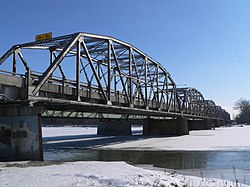Columbus, Nebraska
| Columbus, Nebraska | |
|---|---|
| City | |

Bridge carrying U.S. Highway 30 and U.S. Highway 81 across the Loup River at Columbus
|
|
 |
|
| Coordinates: 41°25′58″N 97°21′31″W / 41.43278°N 97.35861°WCoordinates: 41°25′58″N 97°21′31″W / 41.43278°N 97.35861°W | |
| Country | United States |
| State | Nebraska |
| County | Platte |
| Area | |
| • Total | 10.08 sq mi (26.11 km2) |
| • Land | 9.85 sq mi (25.51 km2) |
| • Water | 0.23 sq mi (0.60 km2) |
| Elevation | 1,447 ft (441 m) |
| Population (2010) | |
| • Total | 22,111 |
| • Estimate (2012) | 22,509 |
| • Density | 2,200/sq mi (850/km2) |
| Time zone | CST (UTC-6) |
| • Summer (DST) | CDT (UTC-5) |
| ZIP codes | 68601-68602 |
| Area code | 402 |
| FIPS code | 31-10110 |
| GNIS feature ID | 0828280 |
| Website | columbusne.us |
Columbus is a city in and the county seat of Platte County, in the state of Nebraska in the Midwestern United States. The population was 22,111 at the 2010 census.
In the 18th century, the area around the confluence of the Platte and the Loup Rivers was used by a variety of Native American tribes, including Pawnee, Otoe, Ponca, and Omaha. The Pawnee are thought to have descended from the Protohistoric Lower Loup Culture; the Otoe had moved from central Iowa into the lower Platte Valley in the early 18th century; and the closely related Omaha and Ponca had moved from the vicinity of the Ohio River mouth, settling along the Missouri by the mid-18th century. In 1720, Pawnee and Otoe allied with the French massacred the Spanish force led by Pedro de Villasur just south of the present site of Columbus.
In the 19th century, the "Great Platte River Road"—the valley of the Platte and North Platte rivers running from Fort Kearny to Fort Laramie— was the principal route of the westward expansion. For travellers following the north bank of the Platte, the Loup River, with its soft banks and quicksands, represented a major obstacle. In the absence of a ferry or a bridge, most of these followed the Loup for a considerable distance upstream before attempting a crossing: the first major wave of Mormon emigrants, for instance, continued up that river to a point about three miles downstream from present-day Fullerton.
The site of Columbus was settled by the Columbus Town Company on May 28, 1856. The group took its name from Columbus, Ohio, where most of the settlers had originally lived. The townsite was selected for its location on the proposed route of the transcontinental railroad.
...
Wikipedia
